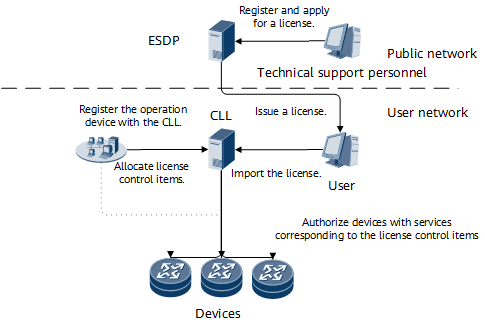Cloud-based License
A cloud-based license is also called a pooled license. It is a solution that enables one NMS to manage multiple NEs and enables each NE to dynamically apply for and release license resources.
The cloud-based license feature allows users to perform comprehensive management (such as entitlement activation, life cycle management, and annual fee management) on license resources of multiple NEs on the OSS WebUI. Each NE can apply for and release license resources from the OSS resource pool, implementing dynamic migration and flexible allocation of license resources among NEs.
Background
In non-cloud-based license mode, the license resources of each device are static and fixed. When license expansion or migration is required for a device, Huawei technical support engineers must revoke the current license to apply for a new license file on the ESDP website and ask the customer to activate the license on the device. The entire process is time-consuming and complex. In cloud-based license mode, the license resource pool is activated and managed on the license management platform. License control items can be dynamically allocated and reclaimed among multiple devices registered in the resource pool to implement license resource sharing and dynamic adjustment among multiple devices.
Definition
ESDP (Electronic Software Delivery Platform): Technical support engineers can apply for and download a license file from the ESDP.
Device Anti-Theft Fundamentals
As shown in Figure 1, a complete cloud-based license solution consists of the following parts:
- Cloud License Local (CLL) server: It is a management platform that creates a license resource pool by activating license files, interacts with NEs to apply for or reclaim license resources, and collects statistics on and displays the license usage in the resource pool. You can manage the CLL server through the GUI of the NMS.
- NMS: On the NMS GUI, users can manage devices registered with the CLL, and display, allocate, and reclaim license control items between devices and the CLL.
- Device: refers to the NE where services are deployed. After the license control items are allocated from the CLL server, you can configure services for the authorized services.
The cloud-based license process model consists of the following parts:
- The technical support personnel apply for a license on the ESDP website, and the ESDP website sends the license file to the user's email box.
- You can import a license file to the CLL server to create a license resource pool.
- A user performs operations on the device through the NMS and registers the device with the CLL server.
- A user allocates license control items from the license resource pool to a device on the NMS GUI.
- The service corresponding to the license control item on the device is authorized, and the customer can configure the corresponding service.
- Users can reclaim license control items from devices to the license resource pool and re-allocate license control items on the NMS.

Unactivated RTU licenses can be recycled to the CLL server. Activated RTUs are bound to corresponding boards and cannot be reclaimed.
Benefits
After the cloud-based license is activated on the CLL server, users can allocate and reclaim license control items on a certain range of devices as required. License resources can be shared among multiple devices in a project, preventing license resource waste caused by uneven allocation, this reduces the overall purchase cost and back-end management cost.
